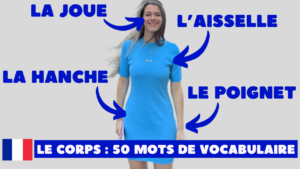Transcription
You've never heard these kitchen objects in French? A ladle, a peeler or a kettle?
Then this video is for you. Welcome to my kitchen. Today, it's a French vocabulary video about the different objects you can find in this room.
We're going to look at some very basic words. It'll give you a chance to brush up on them, but you'll also learn to describe a lot of words I'm sure you don't know about this world of cooking.
Even if these are words we use every day in France, they're not necessarily the first words we learn when we're learning French.
To review this vocabulary, you can download the lesson sheet I've prepared for you. Just click on the link in the video description. Don't hesitate, it's 100% free. And off we go! The most important appliance for me in the kitchen, because it contains all the fresh produce, is the fridge. The fridge is the word we use more in everyday language with the family, in colloquial language. So it's my fridge.
Below the fridge, you have the freezer with all your frozen goods. Here we have the kitchen sink with a few dirty dishes, like this frying pan, for example. Here we have the tap. To wash the dishes, we of course need washing-up liquid or washing-up liquid. We have a sponge. Here, a dishcloth. We call this a dishcloth.
It's for cleaning the worktop, for example, or the table. Here, I have the worktop for cooking. Below the worktop, I've got the dishwasher with even more dirty dishes inside.
Here we have the oven. Here we have an electric hob. You can have a gas stove. Here, it's electric induction. Here are a few things I use every day to cook. We have a grater. You can grate cheese, grate carrots, for example, to make grated carrots.
We have a peeler. A peeler is used to peel vegetables. It's easier than using a knife, normally. Here, we have kitchen knives. And this, in French, is called a fouet. We use it, for example, to make pancake batter.
This little object is a funnel. A funnel. I use it very often when I make French fries, to put the oil back into the bottle. I have the oil in the pan and I pour it through the funnel back into the bottle.
Here we have a ladle used to serve soup. A ladle. Here, you see, I have all my spices. Next to it, I have coarse salt. This is fleur de sel. This is the nobler part of salt, used to put on mozzarella tomatoes, for example. Here, I have classic salt. I use pepper, dried basil, ginger, cinnamon and chilli to add a little spice to my dishes.
Here, I have my oils, to season my salads or to cook my food. And here, vinegar. Vinegar, when mixed with oil, makes a vinaigrette for salads. Here we have ready-made vinaigrette, again for dressing salads. So, let's get back to it.
One of the most common items found in the kitchen are saucepans. You see, they're in two pieces here. A saucepan. This is a cutting board.
You can cut vegetables on it, bread, your ingredients for cooking. It's a colander. I also have a pancake pan. You see, it's much flatter. It's specifically for making pancakes. Behind it, of course, I have two garbage cans.
I have a regular garbage can and a recycling garbage can for cardboard and plastics. At the back, I have dish towels.
Here, I've got aprons so I don't get dirty when I'm cooking. Here's an oven mitt, so you don't burn yourself when you take things out of the oven. Here's a dustpan, a dustpan. I've shown you my dirty dishes.
Now I'll show you my clean dishes. I have some egg cups. You use them to eat boiled eggs. Here, I have a jug or carafe. You see, it's a bit chipped, it's a bit broken. Chipped means that some pieces are gone.
We often use this word for porcelain, to refer to a plate, a dish or a jug. Here, I have a cafetière. In France, we even call it an Italian cafetière, a théière, for drinking tea. Here, I have flat plates.
I've got soup plates. We use soup plates to eat soup or pasta dishes, for example. Here, I have small plates.
That's what they're called, small plates or dessert plates. Here, we'll find my mugs. My favorite mug. There are also bowls and, of course, glasses. Earlier, I showed you my coffee maker. When it's electric, we usually call it a coffee machine. Here, behind my coffee machine, I have my toaster. My toaster for making toast. Sometimes, in French, we say "toast". Then I have my kettle for making tea and heating water.
Here, it's a bit dirty, I need to clean it. This is my hood. It sucks out the fumes and cooking smells. Here are a few other kitchen objects, a scale. We can specify a kitchen scale if necessary, depending on the context. Here you have a trivet, a trivet.
This is what you put underneath a hot pan or dish coming out of the oven, for example, to protect the table.
A trivet. Here, I have a saladier, a salad bowl. This word sounds like "salad". You can use it to make salads, but you can also use it to make other things. And finally, the cutlery drawer. In the basics, we have of course the fork, the knife, a soup spoon and a teaspoon. This is what we call cutlery.
Then, in my cutlery drawer, I also have chopsticks for eating Asian dishes, a corkscrew, which is very important in France for opening bottles of wine, a corkscrew, scissors, a tea ball, a tea ball. If I'm alone drinking tea, I won't necessarily use a teapot.
I'm going to take some loose tea, which isn't bagged, and I'm going to put some tea here and I'm going to plunge it into a cup, with water. And finally, a can opener. A can opener. It opens cans. That's it for today.
Don't hesitate to comment if you know of any other objects or kitchen utensils in French. If you like the video, please "Like" it.
Let me know in the comments if you'd like to learn more home vocabulary. And don't forget to subscribe, activate the bell and download your vocabulary card.
See you soon.







